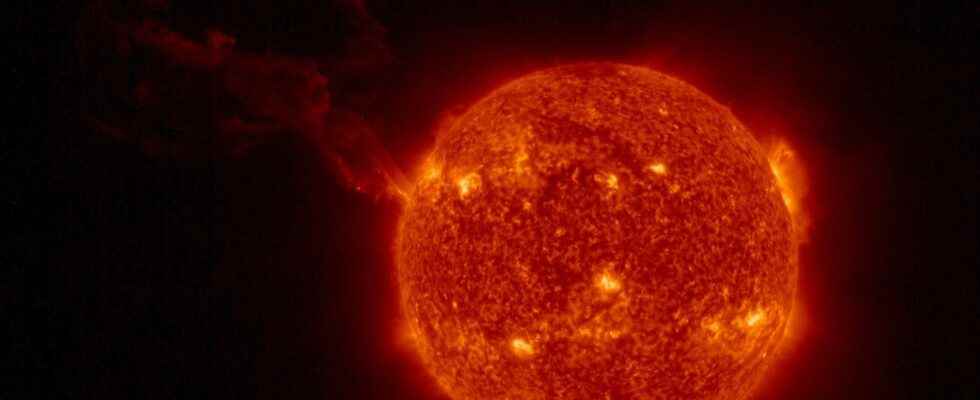The solar flares are not rare phenomena. They occur on the surface of the photosphere of our Star and project matter ionized through its chromosphere. And usually up to hundreds of thousands of miles in space. But the solar flare that the Solar Orbiter mission (ESA, Nasa) recorded this Tuesday, February 15, 2022 was particularly intense. It was accompanied by an ejection of mass coronal which has extended over millions of kilometres.
Luckily for our technologies — which can be damaged by such events — this eruption was not directed at our Earth. It came from the side of Sun in opposition to our planet.
Other missions witnessing the event
But this is the first time that an instrument — the space telescope appointed Extreme Ultraviolet Image (EUI) on board the Solar Orbiter — was able to capture such a massive eruption. One cloud plasma spanning 3.5 million kilometres. All while keeping in mindeye the complete solar disk. Because the EUI was designed for this: to observe the solar disk even during close passages of the mission.
The researchers point out that even gear not intended forobservation of the sun recorded its effects. The Bepi Colombo mission (ESA, Jaxa), for example. Left to study Mercury and currently located near theorbit of the planet closer to the sunthe machine detected a massive influx of electrons, protons and D’ions heavy.
The new Solar Orbiter spacecraft observed its first coronal mass ejection
Solar Orbiter, the joint solar mission of NASA and the European Space Agency (ESA), will not really begin its scientific work until next November. But, last February, while the machine was sailing on the other side of our Sun, it surprised its first coronal mass ejection.
Article of Nathalie Mayer published on 05/25/2021
The coronal mass ejections (EMC) are extremely violent phenomena. In a few minutes, billions of tons of solar matter can be expelled into space. Has gears of the order of a thousand kilometers per second. With potential impacts on Earth. In the form of’thunderstorms magnetic interference which may interfere with some of our technologies and be dangerous for astronauts.
Thus, studying coronal mass ejections is one of the objectives of the Solar Orbiter mission. Last February, precisely, the machine immortalized its first EMC – followed almost immediately by a second. It then crossed about half the distance between Earth and the Sun and finished passing behind our star — from Earth’s perspective. A phase during which the researchers had not considered being able to record data.
Success was on their side. Because not only Solar Orbiter witnessed an EMC at that time, but three of its instruments were able to record it. Offering different perspectives on the phenomenon. Even if the images remain imperfect. Because the mission, launched in February 2020, will not be fully operational until November of this year.
A coronal mass ejection seen from all angles
On the images returned by the Solar Orbiter Heliospheric Imager (SoloHI), the astronomers could see the coronal mass ejection appear as a sudden burst then expanding in the solar wind. I’Extreme Ultraviolet Imager (EUI) — which had already detected a coronal mass ejection as early as last November — made it possible to discover the EMC in the inner part of the solar corona. the coronagraph Metis — which had also already observed such a phenomenon in mid-January –, by blocking the light of the Sun’s surface, meanwhile, offered a view of the EMC on the outer corona. Most of the instruments aboard Solar Orbiter recorded activity at this time. And their data is still being analyzed.
The event was also captured by three other solar missions: Proba-2 (ESA), Stereo-A (Nasa) — understand Solar Terrestrial Relations Observatory –, which was further away, and theSoho Solar and Heliospheric Observatoryplaced on the “front” face of the Sun.
A set of data that was used by the design office of the space weather from NASA to model the trajectory of the coronal mass ejection through the Solar System. While waiting for Solar Orbiter to provide even more details on this phenomenon, once all of its instruments have entered their scientific exploitation phase. See you for this next November.
Interested in what you just read?
